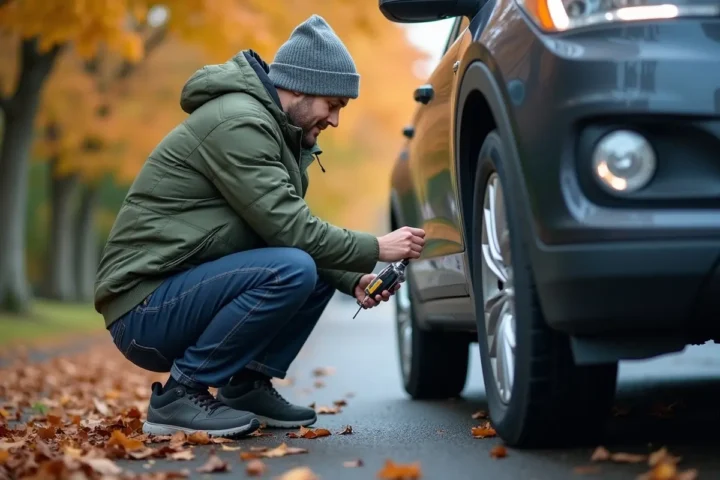Pump It Right: Why Proper Tire Inflation Matters More Than You Think During Seasonal Changes
As the seasons change from summer’s heat to autumn’s chill, most drivers think about basic maintenance like wiper blades or battery checks, but tire inflation often gets overlooked. Keeping your tires properly inflated isn’t just about better fuel efficiency; it’s essential for safety, performance, and preventing accidents that might require the help of an injury attorney for motorcycle accident victims.
Whether you’re on two wheels or four, tire pressure directly affects how your vehicle grips the road, and since temperature changes can dramatically alter it, ignoring this simple detail could end up costing far more than you expect.

How Temperature Impacts Tire Pressure
Tire pressure isn’t static. For every 10°F drop in temperature, your tire pressure can fall by about 1 to 2 PSI (pounds per square inch). That means a cool morning after a warm day could leave your tires underinflated before you even hit the road.
In summer, the opposite happens. Hot weather can increase tire pressure, sometimes leading to overinflation. Either extreme, too little or too much air, affects how your tires grip the road, how they wear down, and how your vehicle responds when braking or turning.
Seasonal shifts aren’t just a concern for car owners. Motorcycle riders are particularly vulnerable because even small pressure changes can dramatically affect balance and traction. Proper inflation helps your tires maintain their designed contact with the road, which becomes especially critical when riding through wet or icy conditions.
Why Underinflated Tires Are More Dangerous Than You Think
Driving on underinflated tires might not seem like a big deal at first glance. Your car still moves, your bike still rides—but beneath the surface, you’re courting trouble.
Underinflated tires create excess friction, which makes them heat up faster. That extra heat weakens the tire’s structure, leading to premature wear or even a blowout at high speeds. In cars, that means a potential loss of control; on a motorcycle, it could mean a serious accident.
Handling also suffers. Underinflated tires make steering sluggish and increase braking distances, especially on slippery or uneven roads. You might not notice the change immediately, but when you need to react quickly—say, avoiding debris or another vehicle—it could make all the difference between a near miss and a collision.
And then there’s the cost factor. Underinflated tires decrease fuel efficiency, forcing your engine to work harder and burn more gas. Over time, that can add up to hundreds of dollars wasted simply because of neglected tire maintenance.
The Risks of Overinflation: When Too Much Air Isn’t a Good Thing
While underinflation gets most of the attention, overinflation can be just as risky. When there’s too much air in your tires, the contact patch—the area of rubber that actually meets the road—shrinks. Less contact means less traction.
Overinflated tires are also more susceptible to damage from potholes or debris. The stiffer structure can’t absorb impacts as well, leading to cracks, punctures, or even sidewall blowouts. The result? A rougher, less predictable ride and a greater chance of losing control during sharp turns or emergency maneuvers.
This is particularly important for motorcyclists. With only two tires separating you from the pavement, maintaining the perfect pressure balance is essential. Too much air can make a bike feel unstable, especially when cornering or braking suddenly.
The Smart Seasonal Habit: Check, Adjust, Repeat
The best time to check your tire pressure is when the seasons start to change—or even better, once a month, year-round. Invest in a reliable tire gauge and know your vehicle’s recommended PSI (found in the owner’s manual or on the driver’s side door frame).
If you’re using a motorcycle, your manufacturer’s recommendations may vary based on load and riding conditions, so always double-check before long rides.
Also, remember that temperature fluctuations can happen within a single day. A tire inflated adequately in the afternoon might read low the next morning. That’s why consistency is key. Regular checks help ensure you’re not caught off guard by sudden cold snaps or heat waves.
A Little Air Goes a Long Way
Proper tire inflation may seem like a small detail, but it’s one of the simplest ways to stay safe and save money throughout the year. As the seasons change, so do road conditions—and the last thing you want is to risk your safety over something as easy to fix as air pressure.
For motorcycle riders, especially, the stakes are even higher. A sudden loss of traction or control can lead to life-changing consequences. If you or someone you know has been injured in a motorcycle accident, it’s crucial to seek guidance from an injury attorney for motorcycle accident victims. The right legal help can make all the difference in navigating recovery and ensuring fair compensation.
Conclusion
So before the weather shifts again, take a few minutes to check your tires. That small step can mean safer roads, smoother rides, and greater peace of mind—no matter what the forecast brings.


